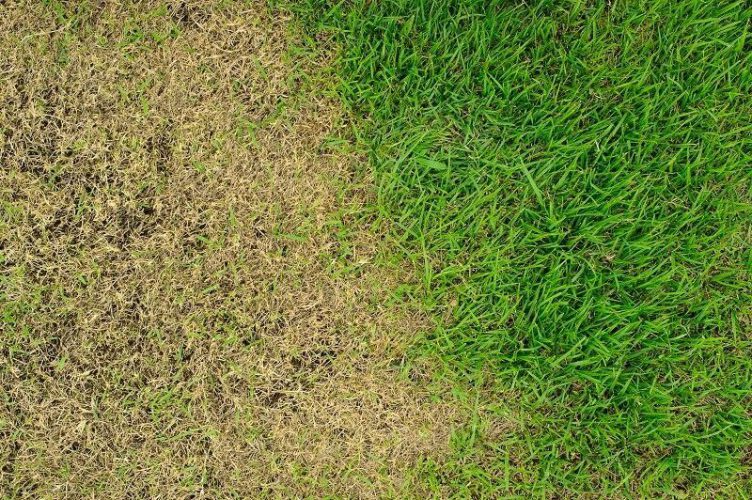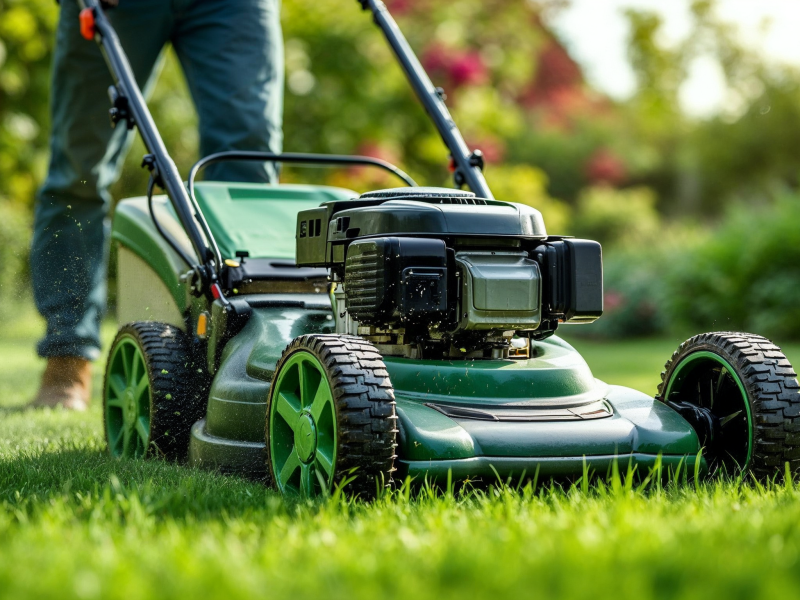Dry patch affects lawns all around the country and can be difficult to know how to treat. Read this blog from Greensleeves to learn more about what dry patch is, how to prevent it and how to treat it once it has affected your lawn.
What Is Dry Patch?
Dry patch sounds fairly self-descriptive: at its most simple, it describes the formation of a dry area on your lawn where the grass becomes discoloured (and sometimes dies) due to lack of moisture.
However, dry patch is not the same as normal dry soil. Patches of dry soil are fairly common, but after rainfall or watering, fully recover. Dry patch, on the other hand, isn’t resolved when you, or the rain, waters the lawn.
Instead, the soil cannot absorb or retain water and therefore remains dry even in wet conditions. It has become hydrophobic (water-repellent). This means the grass becomes increasingly unhealthy and can ultimately die as it suffers from drought conditions.
It can affect lawns of all sizes from small gardens to golf courses. It disrupts the appearance of the lawn and affects the health of the grass. Unless the soil is treated so it can absorb water again, reseeding to fill in the patch won’t have any effect.
What Causes Dry Patch?
Dry patch still isn’t completely understood and the causes are complicated and extensive. However, there are a number of things that are known to cause or impact it:
- Insect pests
- Fungal diseases
- Spilt mower fuel
- Dog or fox urine
- Other chemical changes in the soil
There are other factors that make a lawn more prone to dry patch, but aren’t direct causes:
- Compact soil
- Light soil
- Thick thatch
- Allowing the soil to become dry
Fungal Causes
While the causes are complicated, one of the most common is thought to be fungus on the grass — or more specifically, the water-repellent substances that the fungus deposits in the soil.
The fungus itself that causes this isn’t a pathogenic species. This means that it isn’t in itself something that causes harm to the grass. In fact, a lot of this fungi is helpful: it breaks down dead roots, leaves and stems from the thatch layer of the grass, which is essential for the life cycle and development of your lawn.
However, it is also thought that the fungi that cause fairy rings, which aren’t helpful to your lawn, also deposit water-repellent chemicals.
As the fungus moves through the soil and/or thatch layer, it deposits chemicals that cause moisture resistance. Trace amounts of these will make little difference to your grass, but large amounts — or small amounts when combined with other causes — can lead to dry patch.
Because of this, one of the ways to prevent dry patch is to keep lawn thatch under control. Too much lawn thatch will increase the risk of a high amount of fungi breaking down the dead material and depositing water-resistant chemicals. You can read more about preventing dry patch below.
Preventing Dry Patch
The best way to deal with dry patch, is to prevent it from affecting your lawn. It’s possible to treat dry patch once it has become an issue, but it’s significantly easier to take steps to keep it at bay. These steps are also helpful for generally improving grass health and the appearance of your lawn.
1. Lawn Scarifying
Scarification removes a layer of thatch from your grass. It’s best to get an expert to scarify your lawn as they will analyse the thatch layer and remove the right amount to keep your grass healthy. Professional scarifiers are often significantly more effective than DIY ones that are available to rent or buy. Read more about scarification with Greensleeves.
Sacrificing is often best done in the autumn to reduce the risk of dry patch throughout the following year.
2. Aeration
Another trigger (or perhaps catalyst) that makes your lawn more prone to dry patch is soil compaction. Compact soil can’t absorb water as effectively and often starts to dry out. An aeration treatment should be carried out at least once a year to prevent compaction and to ensure your soil can take on water.
For some lawns, it might be appropriate to have an aeration treatment more than once a year, depending on your soil type and lawn. Aeration also needs to be completed before other kinds of treatments, like a hydration treatment.
We recommend hollow tine aeration over spiking as this is significantly more effective at reducing compaction and improving drainage.
3. Feeding the Grass
Having a strong and healthy grass root system also helps to prevent dry patch. To ensure your grass is as healthy as possible, it needs to be fed with an appropriate fertiliser for each time of year — for example, a fertiliser high in nitrogen at the beginning of the growing season.
Greensleeves offers a programme of five seasonal treatments to feed your lawn appropriately every season so it stays healthy. This is a great way to minimise the risk of dry patch forming. Find out more about our seasonal treatments.
Preventing Recurrence
If dry patch has previously affected your lawn, it’s important to take steps to prevent it from occurring again. These steps are the same as the above and are largely focused on keeping your grass healthy.
You can also use a professional wetting agent to ensure that your soil stays moist and is able to absorb moisture as effectively as possible. This should be carried out as part of a hydration treatment that combines aeration with the application of a wetting agent.
Is Your Grass Suffering?
How can you tell if your lawn is suffering from dry patch? The first thing you’ll notice is areas of dry and discoloured grass. This can occur in dry conditions, so water the area well over a week or two and see if it improves.
If the grass doesn’t improve as a result of watering, and the soil is bone dry to touch, then your lawn could be suffering from dry patch. The best thing to do is to get in touch with Greensleeves. A lawn expert will come and evaluate your lawn to give a recommendation of the treatment that will be most effective for you.
How To Treat Dry Patch
If your lawn is suffering from dry patch, it’s best to get the experts in as it can be extremely difficult to rehydrate hydrophobic soil.
A professional will be able to check that it is dry patch affecting your lawn and carry out a bespoke treatment that will solve the problem. This will often involve an aeration treatment and the application of a wetting agent, and might need repeating several times to eradicate the problem. This sometimes then needs to be followed by overseeding (also called reseeding) to then replace the damaged or dead grass.
In extreme circumstances, the area of turf might need to be renovated completely.
If you think your lawn might have dry patch, get in touch with Greensleeves today! You can call us on 0808 100 1413 or fill out a form on our contact page.





